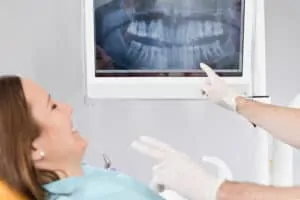Archives

What Exactly is A Dental X-Ray?
X-rays (also referred to as radiographs) can be 2D or 3D images that quickly become an important part of how your Sparks dentist prepares an accurate treatment plan. The images give us an idea of what’s going on inside your mouth, highlighting your jaw bone health and tooth structure that lies beneath your gums and enamel. It gives us the added ability to find out if something is going on inside your mouth or teeth that’s not 100 percent visible to the naked eye.
With the advancements in dental technology, there are many different types of x-rays available on both traditional film and digitally. Most dental offices have made the switch to digital x-rays because they tend to emit nearly 80 percent less radiation than film x-rays. Many dentists find that digital x-rays free up appointment times and are easy to save to a patient’s file for future reference and use.
Intraoral and Extraoral: The Two Main Categories of X-Rays
Besides having the ability to be either taken on film or stored digitally, x-rays are divided down into two other categories of either being intraoral or extraoral. How it breaks down is pretty straightforward, and it goes something like this:
Intraoral x-rays – involve any imaging taken from INSIDE your mouth
Extraoral x-rays – involve any imaging taken from OUTSIDE your mouth
Intraoral x-rays give us the chance to see really minute or fine details of both your supporting bone and teeth. They are the most common type of dental x-ray and provide an extremely high level of detail to help us diagnose cavities, examine your tooth roots, look over your bony areas, check the status of developing teeth or ones that have yet to erupt, and more.
Extraoral x-rays are usually relied on to help dentists and orthodontists focus on the bones in your head, particularly your upper and lower jaw. Think of them as x-rays that can help us see the big picture of what’s going on in and around your head and mouth. They help us look at growth and development, monitor impacted teeth, and assess bite issues. Extraoral x-rays tend to be less detailed than the intraoral variety.
Are Dental X-Rays Safe?
Most of the x-rays used in dental offices across the country today give off a minimal amount of radiation. It’s important to note that you should always limit your exposure to x-rays and avoid repeated use as it can damage cells over time due to the small, continued radiation aftereffects.
Dental x-rays are certainly safer than ever thanks to advancements in dentistry over the years. Dentists now rely on using lower x-ray dosages, higher quality film, film holders, and well-designed, full-body aprons lined with lead. It’s important to note though that most of the modern dental x-ray technology that’s available today give off very little stray radiation.
We hope you’ve learned a little bit about dental x-rays and how critical they are in helping your dentist in Sparks make sure your mouth is always in optimal health, from your teeth to your bones. X-rays can help you big time because they allow us to detect issues early before they become more costly to fix down the road. If you have any questions about your dental x-rays or when you’re due for a new set, please don’t hesitate to give us a call.

#1: Calcium can help protect your teeth.
Your bones and teeth store nearly all of the calcium within your body, according to findings from the National Institutes of Health. Calcium can make your teeth more resistant to bad stuff such as cavities and decay.
Besides making your bones and teeth stronger, calcium also helps your muscles and blood vessels work more effectively. Babies need calcium to help their teeth and bones grow strong. Young children are the same way.
#2: Adults need the right amount of calcium in their diet.
Your Sparks dentist will tell you calcium is 100% good for your smile because it can help strengthen your enamel so that you’ve got added protection against early tooth deterioration. That’s why adults should make sure that they monitor their calcium intake too, in order to avoid osteoporosis or brittle bones as they age. But what is the daily recommended amount of calcium for adults? According to the Mayo Clinic it’s around:
MEN
- 19-50 years old – 1,000mg daily
- 51-70 years old – 1,000mg daily
- 71 and older – 1,2000mg daily
WOMEN
- 19-50 years old – 1,000mg daily
- 51 and older – 1,200mg daily
#3: Calcium doesn’t always have to come from dairy.
Helping your smile stay healthy with calcium can be tricky if you struggle with lactose intolerance… or simply don’t eat or like dairy products such as yogurt, cheese, and milk. The good news is that companies are starting to wise up and fortify their food products with calcium. You’ll see this in orange juices, waffles, and even tofu. Canned fish, leafy greens, almonds, beans, and soy milk are calcium-rich dairy substitutes you’re welcome to try at home.
Getting the right amount of calcium in your diet, no matter what your age, is very important to help keep your smile and your gums healthy. It’s really a benefit that your whole body will thank you for. We thank you for reading your blog. If you have any questions about your smile or need to schedule a visit with your dentist in Sparks, call us to get started.
